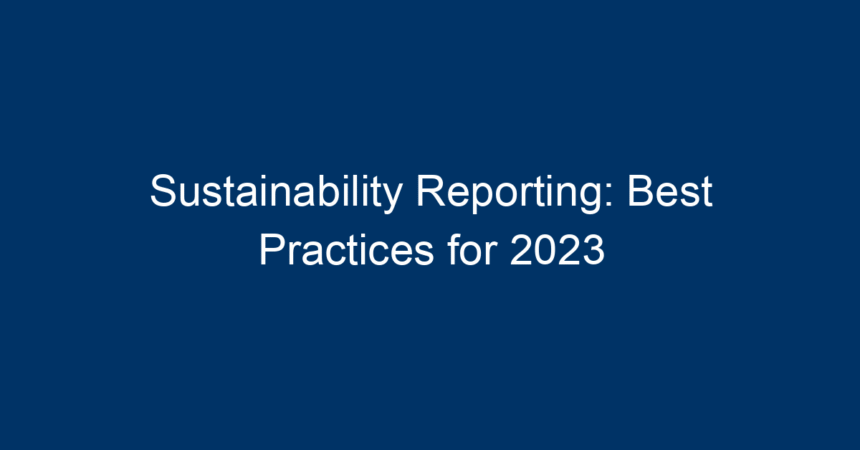In an era where climate change and social responsibility dominate global conversations, sustainability reporting has emerged as a critical tool for organizations aiming to showcase their commitment to environmental and social governance (ESG). As stakeholders—ranging from customers to investors—demand more transparency, companies must adapt their reporting practices. This article explores the best practices for sustainability reporting in 2023, offering a roadmap to creating robust, credible reports that resonate with audiences and drive meaningful change.
Understanding Sustainability Reporting
What is Sustainability Reporting?
Sustainability reporting involves the disclosure of an organization’s environmental, social, and governance performance. It serves as a transparent communication channel that helps stakeholders understand the organization’s sustainability goals, strategies, and impacts. In 2023, sustainability reporting not only reflects corporate responsibility but also identifies opportunities for innovation and improvement.
The Importance of Sustainability Reporting
Organizations across various sectors recognize the significance of sustainability reporting for several reasons:
-
Regulatory Compliance: Increasingly stringent regulations require companies to disclose their sustainability practices.
-
Stakeholder Engagement: Investors and consumers are more likely to support companies that prioritize sustainability.
-
Risk Management: Identifying environmental and social risks is crucial for long-term sustainability.
- Competitive Advantage: Effective sustainability reporting can differentiate a company in the marketplace.
Best Practices for Sustainability Reporting in 2023
1. Align with Global Standards
In 2023, aligning your sustainability reporting with reputable global frameworks is essential. The Global Reporting Initiative (GRI), Sustainability Accounting Standards Board (SASB), and Task Force on Climate-related Financial Disclosures (TCFD) provide guidelines that enhance the credibility of your reports. By adhering to these standards, organizations can ensure their reports meet stakeholder expectations and regulatory requirements.
2. Focus on Materiality
Materiality is foundational in sustainability reporting. Organizations must identify and address the most relevant issues that impact their business and stakeholders. Conduct materiality assessments by engaging stakeholders in the process, which allows you to prioritize sustainability issues that matter most to your audience. This tailored approach boosts the relevance of your report, ensuring it resonates with stakeholders.
3. Leverage Technology and Data Analytics
Data is at the heart of effective sustainability reporting. In 2023, organizations should harness data analytics to track and report sustainability metrics accurately. Use digital tools and software that facilitate data collection and visualization. By employing advanced analytics, companies can derive insights from their data, allowing for more informed decision-making and clearer reporting.
4. Embrace Transparency and Authenticity
Modern stakeholders crave transparency. When creating a sustainability report, don’t shy away from discussing challenges alongside successes. Highlighting both sides of your sustainability journey builds credibility and trust. Use case studies, real-world examples, and anecdotal evidence to illustrate your company’s efforts and challenges in meeting sustainability goals.
5. Set Clear Goals and Metrics
Establishing clear, measurable sustainability goals is crucial. In your report, communicate your objectives and the metrics you will use to track progress. SMART (Specific, Measurable, Achievable, Relevant, Time-bound) goals are particularly effective. For example, instead of stating “we aim to reduce waste,” specify “we will reduce waste by 20% within three years.”
6. Engage with Stakeholders
Incorporating stakeholder feedback enhances the effectiveness of your sustainability reporting. Solicit input from employees, customers, suppliers, and community members throughout the reporting process. Their perspectives can provide valuable insights that help refine your sustainability strategy and demonstrate that you value their opinions.
7. Integrate ESG Factors into Business Strategy
For sustainability reporting to be truly effective, it must be embedded into your overall business strategy. In 2023, companies should articulate how their sustainability initiatives align with long-term business objectives. This alignment not only ensures coherence in messaging but also reinforces the notion that sustainability is integral to the company’s success, not just an add-on.
8. Utilize Engaging Content Formats
Beyond traditional reporting formats, consider incorporating different content types into your sustainability reporting. Interactive dashboards, infographics, videos, and podcasts can engage diverse audiences and make your report more accessible. By using various formats, you can convey complex sustainability issues in a clear and compelling manner.
9. Communicate Progress Regularly
Sustainability reporting should not be a one-off event. In 2023, companies should adopt a continuous reporting approach, updating stakeholders on progress throughout the year. This can involve quarterly updates, newsletters, or dedicated sections on the company’s website. Regular communication reinforces accountability and keeps sustainability at the forefront of stakeholder minds.
10. Train Your Team
Investing in training for your team is vital for effective sustainability reporting. Employees across departments should understand the importance of sustainability and how their roles contribute to achieving sustainability goals. Training programs can foster a culture of sustainability, leading to more robust and impactful reporting.
Conclusion: The Future of Sustainability Reporting
As we navigate through 2023, effective sustainability reporting will continue to evolve. Organizations that embrace best practices—such as aligning with global standards, focusing on materiality, and engaging stakeholders—will set themselves apart in an increasingly competitive landscape.
Taking actionable steps towards enhancing your sustainability reporting can translate into improved relationships with stakeholders and long-term organizational success. By being transparent, authentic, and accountable, you can build trust with your audience and highlight your commitment to a more sustainable future.
Embrace these best practices for sustainability reporting and pave the way for a greener, more equitable world. As you embark on this journey, remember that sustainability is not just a goal; it’s a continuous process of growth, learning, and engagement.
Actionable Insights
- Start by aligning with at least one global reporting standard to enhance credibility.
- Conduct a materiality assessment to identify key sustainability issues relevant to your stakeholders.
- Invest in data analytics tools to accurately track and report on sustainability metrics.
- Embrace transparency by sharing both successes and challenges in your sustainability journey.
- Engage stakeholders regularly to gather feedback and refine your sustainability strategies.
By implementing these insights, your organization can not only enhance its sustainability reporting but also contribute positively to the global push for sustainability. Remember, every small step toward sustainability matters, and your reporting is an essential part of that journey.




